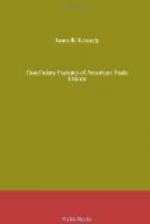[Footnote 33: Constitution, 1904 (Washington, 1904), p. 3.]
[Footnote 34: The Postal Record, Vol. 4, pp. 8, 118, 119.]
[Footnote 35: Ibid., Vol. 5, p. 528.]
All the railway organizations described above make a distinction between death and disability insurance, and sick and accident insurance. The local unions have been prohibited either specifically or by implication from maintaining any association or society for paying death and disability benefits. This rule was first established by the Conductors. During the early years of the Conductors’ national organization, 1868-1880, many subordinate divisions maintained mutual benefit associations for the payment of death and disability insurance. The growth of the national benefit department was thus retarded, and at the tenth annual session in October, 1877, subordinate divisions were prohibited from maintaining “mutual benefit societies."[36] The national organizations, on the other hand, do not furnish accident insurance, but leave this function to the local bodies. In the formation of this policy, also, the Conductors took the initiative by providing in their first national constitution in December, 1868, that the order should never become a weekly benefit association.[37] The Engineers had a similar provision as early as September, 1869; but national regulations governing the payment of weekly benefits were nevertheless formulated. The other unions have followed this policy, and their constitutions provide that the weekly benefits shall be levied, collected, and distributed according to national rules.
[Footnote 36: Proceedings of the Order of Railway Conductors of America, 1868-1885 (Cedar Rapids, 1888), p. 207.]
[Footnote 37: Ibid., p. 21.]
The most striking characteristic of the insurance features of these organizations has been the combination of disability and death insurance. The fact that railway employees are specially exposed to the risks of disabling accidents has been the chief influence in this direction. The large number of claims paid for disability in the Conductors’, the Firemen’s, and the Trainmen’s beneficiary departments during recent years shows the high importance of disability insurance to the men engaged in the more hazardous occupations. The disability claims paid among the Firemen for the eleven years from 1894 to 1904 were 24.5 per cent. of the total number of claims paid, or about one third of the number of death claims paid. Among the Conductors the disability claims, paid during the same period, amounted to one seventh of the death claims paid. The disability claims paid by the Trainmen during twenty years, 1884-1904, were 32.5 per cent. of all claims paid.




